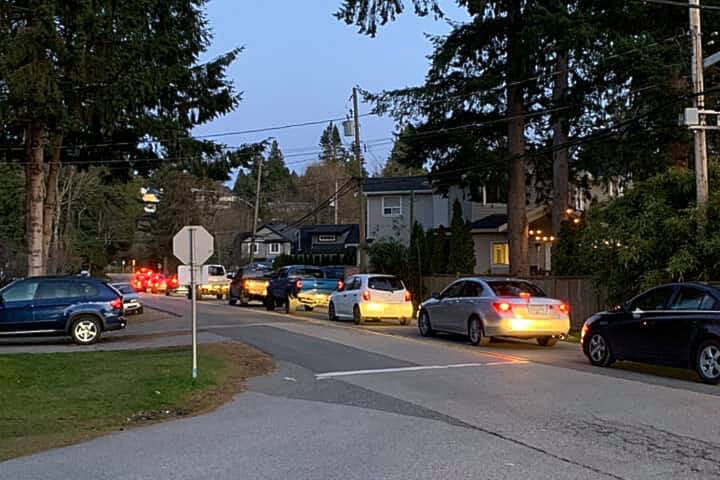Crescent Beach residents say their tiny community’s ability to accommodate vehicle traffic has exceeded its limit, and they want the city to help alleviate the issue.
Trish McEvoy emphasized Monday (March 21) that the idea behind a planned request to institute pay parking, speed bumps and a resident-parking permit system is not about restricting visitor access to the popular foreshore, but about increasing safety in the neighbourhood by encouraging those who do come to find less-congesting ways of getting there.
“People are very welcome to walk down, bike down,” carpool or take the bus, she said, but with daily vehicle volumes as high as 13,000, it’s a “community under siege.”
McEvoy has called Crescent Beach home for 20 years, and currently chairs the Crescent Beach Property Owners’ Association’s traffic committee. The committee was struck a year ago to look at solutions to traffic concerns, however, the issue itself – which is not unique to Crescent Beach – dates back much further.
Vehicle volume on the community’s eight streets has been on the rise over the past decade, McEvoy said, citing gridlock that often blocks residents’ driveways, turns short trips to places like the grocery store into hours-long frustrations, and at times creates a line of traffic that stretches all the way back to King George Boulevard.
READ ALSO: Surrey releases concept drawings for Crescent Beach overpass
Recognition of a need to encourage alternative ways of getting there is also not new – volunteers researching solutions found it proposed in land-use plans dating back to 1999.
McEvoy said committee members began canvassing their community last June, taking petitions regarding the three first-steps-towards-relief ideas to each of the 404 homes.
The vast majority of residents agreed the current situation is not sustainable, she said, noting some residents have already moved away because of it.
“We have heard loud and clear that the community is very frustrated with the current situation,” she said.
“There has to be some reasonable expectation of using your homes in a reasonable manner. None of these people moved here anticipating that they wouldn’t be able to leave their homes on a Saturday.”
Results of the findings are to be shared at a members-only meeting next week, and McEvoy said it’s hoped conversations with the City of Surrey will follow soon after. The committee would like to see the three proposed changes piloted together, ahead of the coming summer season.
McEvoy noted that permit parking is not being sought as a means of ensuring that residents can park in front of their homes – most have driveways – but rather to increase safety by deterring visitors from repeatedly circling the neighbourhood looking for a spot.
The speed bumps, as well, are about safety; to remind drivers of the neighbourhood’s 30 km/h limit.
“This is kind of a giant school zone and that has been lost of people coming down here,” McEvoy said. “We have a serious safety issue with the way that the traffic here has been behaving.”
Another important part of the equation is the impact on the Blackie Spit. The park is an important rest stop for migrating birds on the Pacific Flyway, but its protected status has been “almost forgotten,” McEvoy said.
In coming up with their three-prong approach, the committee looked into communities including Deep Cove in North Vancouver, and even places in California.
One theme was prevalent: “Foreshores everywhere else except for Crescent Beach have acknowledged there has to be a balance.”
In Tsawwassen, McEvoy said, a shuttle runs every half hour between the Delta rec centre and Centennial Beach, while in some California towns, no cars are allowed to park within seven blocks of the beach. And, everywhere else has pay parking.
She said the changes proposed for Crescent Beach are “a starting point in the conversation.” The bottom line, she said, is it’s not workable to continue thinking that everybody in the Lower Mainland can access a 400-home community at the same time.
“It has to be more of a balance. We would like to work with the city to find other solutions.”
In an emailed statement Thursday morning (March 24), officials with the City of Surrey’s engineering department said staff have been working with the property owners’ association regarding “numerous concerns about traffic, perceived safety issues, and parking.”
The statement notes that speed humps were installed north of Sullivan Street “in recognition of concerns with livability associated with higher than expected traffic volumes.”
However, that move was an exemption to the city’s Traffic Calming policy, and the area as a whole “does not meet the city-wide threshold for installing speed humps as analysis of the roads indicated compliance with speed limits were good and there was no extensive history of reported collisions.”
The city is open to discussing pay parking and resident permits, the statement continues. A comprehensive parking and and traffic management study would need to be part of that, and “would need to consider the unique balance of supply and demand that includes seasonal variation associated with parks and beach-related destinations, residential parking supply, on-street public parking, appropriate cost recovery of a resident-parking permit program, and access to support established commercial/retail entities.”
“This City will be considering initiating a comprehensive process for the area with a target of conducting Parking Study-related work next year.”
tholmes@peacearchnews.com
Like us on Facebook and follow us on Twitter www.peacearchnews.com/newsletters
